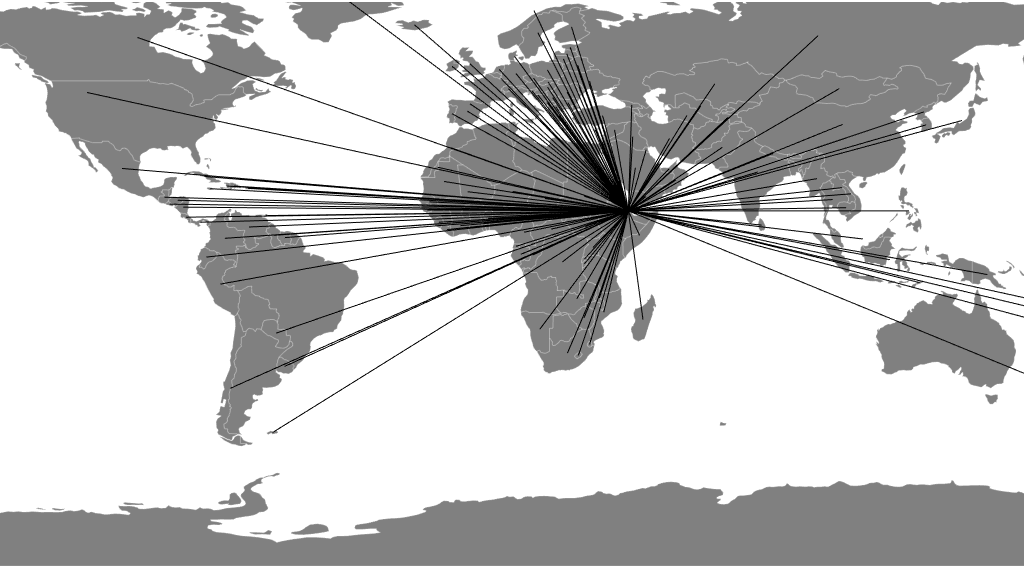This is a Livecoding Recap – an almost-weekly post about interesting things discovered while livecoding ?. Always under 500 words and with pictures. You can follow my channel, here. New content almost every Sunday at 2pm PDT. There’s live chat, come say hai ?
You know, it's really hard to compete with the Super Bowl. This Sunday must have been the lowest live coding turnout I've ever seen.
A cumulative of 80 people came to see me live, and that makes me happy, and I still don't know how liveedu.tv calculates that. It doesn't matter. It's a number, it's not zero, and that's great.
Thanks to mrmaru for teaching me how to jump to the end of line ($) and beginning of line (0) in Vim. I sure feel dumb for holding the left and right arrow keys for the past 15 years like an idiot. Why didn't I look that up? ?
Together, we talked about not understanding football and built this map:

We're going to make it better next week. I know it doesn't look like much yet.
Our (my?) goal is to build a map of global migrations using the UN dataset I mentioned last week. Initially, I wanted to build one of those cool maps that change country sizes to represent a value. No idea how to do that. Yet.
Instead we're drawing lines. Because I couldn't figure out how to make curves ?
In my defense, I was tired and dying from a cold.
Right now, you're seeing global migrations into Djibouti. Lines connect source migrations to their destination. There's nothing about magnitude yet. That comes next week, and I'd love some suggestions on how to do that. Line thickness smells interesting but would probably look weird.
Oh, and the lines are going to be curved. I think what I'm missing is a third point between the source and destination. Something to give D3's curve curveBasis interpolator a reason to make a curve.
Right now we're rendering the migrations layer as a React component, like this:
const Migrations = ({ topology, projection, data, nameIdMap }) => {
const countries = topojson.feature(topology, topology.objects.countries),
path = d3.geoPath(projection),
centroids = _.fromPairs(countries.features
.map(country => [country.id,
path.centroid(country)]));
return (
<g>
<countrymigrations data={data[10]} nameidmap={nameIdMap} centroids={centroids}>
</countrymigrations></g>
);
};
const CountryMigrations = ({ data, nameIdMap, centroids }) => {
const line = d3.line()
.curve(d3.curveBasis),
destination = centroids[data.id];
console.log(data.name);
const sources = Object.keys(data.sources)
.filter(name => centroids[nameIdMap[name]])
.map(name => centroids[nameIdMap[name]]);
return (
<g>
{sources.map((source, i) => (
<path d="{line([destination," source])}="" style="{{stroke:" 'black',="" strokewidth:="" '1px'}}="" key={`${data.id}-${i}`}>
))}
</path></g>
)
};
The Migrations component builds a dictionary of country centroids, which gives us a cached mapping from country id to country centroid position. We use these as line anchors.
Then we iterate through the list of countries and render CountryMigration components. Well, in theory. There's just one CountryMigration right now, so it's easier to debug.
Each CountryMigration component creates a d3.line generator, compiles a list of sources, then iterates through them and adds path elements for each line. As you can see, this works, but it doesn't make curves because a curve between two points is a straight line.
That sounds stupidly obvious when I say it out loud ?
Join me next week as we curve the curves, add animation to represent migration volume, and maybe some interactivity. Mouseovers could filter countries? Perhaps.
Continue reading about Livecoding #32: A Map of Global Migrations, Part 1
Semantically similar articles hand-picked by GPT-4
- Livecoding #33: A Map of Global Migrations, Part 2
- Livecoding #34: A Map of Global Migrations, Part 3
- Livecoding #31: Wherein we learn that datasets are hard and find 2 good papers
- Livecoding #24: A choropleth in React.js
- Livecoding #27: New React Indie Bundle page almost done
Learned something new?
Read more Software Engineering Lessons from Production
I write articles with real insight into the career and skills of a modern software engineer. "Raw and honest from the heart!" as one reader described them. Fueled by lessons learned over 20 years of building production code for side-projects, small businesses, and hyper growth startups. Both successful and not.
Subscribe below 👇
Software Engineering Lessons from Production
Join Swizec's Newsletter and get insightful emails 💌 on mindsets, tactics, and technical skills for your career. Real lessons from building production software. No bullshit.
"Man, love your simple writing! Yours is the only newsletter I open and only blog that I give a fuck to read & scroll till the end. And wow always take away lessons with me. Inspiring! And very relatable. 👌"
Have a burning question that you think I can answer? Hit me up on twitter and I'll do my best.
Who am I and who do I help? I'm Swizec Teller and I turn coders into engineers with "Raw and honest from the heart!" writing. No bullshit. Real insights into the career and skills of a modern software engineer.
Want to become a true senior engineer? Take ownership, have autonomy, and be a force multiplier on your team. The Senior Engineer Mindset ebook can help 👉 swizec.com/senior-mindset. These are the shifts in mindset that unlocked my career.
Curious about Serverless and the modern backend? Check out Serverless Handbook, for frontend engineers 👉 ServerlessHandbook.dev
Want to Stop copy pasting D3 examples and create data visualizations of your own? Learn how to build scalable dataviz React components your whole team can understand with React for Data Visualization
Want to get my best emails on JavaScript, React, Serverless, Fullstack Web, or Indie Hacking? Check out swizec.com/collections
Did someone amazing share this letter with you? Wonderful! You can sign up for my weekly letters for software engineers on their path to greatness, here: swizec.com/blog
Want to brush up on your modern JavaScript syntax? Check out my interactive cheatsheet: es6cheatsheet.com
By the way, just in case no one has told you it yet today: I love and appreciate you for who you are ❤️
